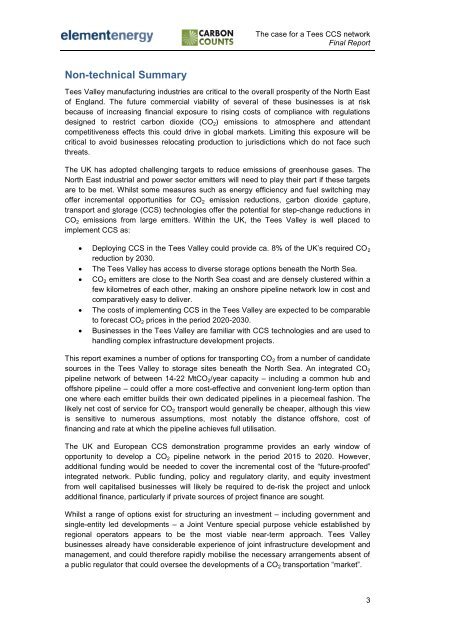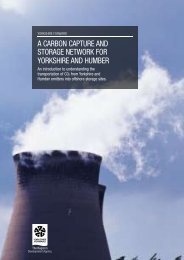Final report for One North East And NEPIC 21/12/10 - The Carbon ...
Final report for One North East And NEPIC 21/12/10 - The Carbon ...
Final report for One North East And NEPIC 21/12/10 - The Carbon ...
You also want an ePaper? Increase the reach of your titles
YUMPU automatically turns print PDFs into web optimized ePapers that Google loves.
<strong>The</strong> case <strong>for</strong> a Tees CCS network<strong>Final</strong> ReportNon-technical SummaryTees Valley manufacturing industries are critical to the overall prosperity of the <strong>North</strong> <strong>East</strong>of England. <strong>The</strong> future commercial viability of several of these businesses is at riskbecause of increasing financial exposure to rising costs of compliance with regulationsdesigned to restrict carbon dioxide (CO 2 ) emissions to atmosphere and attendantcompetitiveness effects this could drive in global markets. Limiting this exposure will becritical to avoid businesses relocating production to jurisdictions which do not face suchthreats.<strong>The</strong> UK has adopted challenging targets to reduce emissions of greenhouse gases. <strong>The</strong><strong>North</strong> <strong>East</strong> industrial and power sector emitters will need to play their part if these targetsare to be met. Whilst some measures such as energy efficiency and fuel switching mayoffer incremental opportunities <strong>for</strong> CO 2 emission reductions, carbon dioxide capture,transport and storage (CCS) technologies offer the potential <strong>for</strong> step-change reductions inCO 2 emissions from large emitters. Within the UK, the Tees Valley is well placed toimplement CCS as: Deploying CCS in the Tees Valley could provide ca. 8% of the UK‟s required CO 2reduction by 2030. <strong>The</strong> Tees Valley has access to diverse storage options beneath the <strong>North</strong> Sea. CO 2 emitters are close to the <strong>North</strong> Sea coast and are densely clustered within afew kilometres of each other, making an onshore pipeline network low in cost andcomparatively easy to deliver. <strong>The</strong> costs of implementing CCS in the Tees Valley are expected to be comparableto <strong>for</strong>ecast CO 2 prices in the period 2020-2030. Businesses in the Tees Valley are familiar with CCS technologies and are used tohandling complex infrastructure development projects.This <strong>report</strong> examines a number of options <strong>for</strong> transporting CO 2 from a number of candidatesources in the Tees Valley to storage sites beneath the <strong>North</strong> Sea. An integrated CO 2pipeline network of between 14-22 MtCO 2 /year capacity – including a common hub andoffshore pipeline – could offer a more cost-effective and convenient long-term option thanone where each emitter builds their own dedicated pipelines in a piecemeal fashion. <strong>The</strong>likely net cost of service <strong>for</strong> CO 2 transport would generally be cheaper, although this viewis sensitive to numerous assumptions, most notably the distance offshore, cost offinancing and rate at which the pipeline achieves full utilisation.<strong>The</strong> UK and European CCS demonstration programme provides an early window ofopportunity to develop a CO 2 pipeline network in the period 2015 to 2020. However,additional funding would be needed to cover the incremental cost of the “future-proofed”integrated network. Public funding, policy and regulatory clarity, and equity investmentfrom well capitalised businesses will likely be required to de-risk the project and unlockadditional finance, particularly if private sources of project finance are sought.Whilst a range of options exist <strong>for</strong> structuring an investment – including government andsingle-entity led developments – a Joint Venture special purpose vehicle established byregional operators appears to be the most viable near-term approach. Tees Valleybusinesses already have considerable experience of joint infrastructure development andmanagement, and could there<strong>for</strong>e rapidly mobilise the necessary arrangements absent ofa public regulator that could oversee the developments of a CO 2 transportation “market”.3







